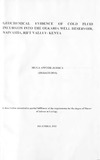| dc.description.abstract | The study to establish the presence of cold fluid incursion into a geothermal reservoir using
geochemical evidence was carried out in the greater Olkaria geothermal field. The greater
Olkaria geothermal field is situated in Nakuru County, south of Lake Naivasha on the floor of
the southern segment of the Great Rift Valley within the Kenyan rift. The wells in north east
field, central field and Olkaria East field were monitored closely in order to establish
conclusively the presence of the cold fluid into the reservoir. This was achieved through
determination of fluid chemistry of geothermal fluids in Olkaria fields, geothermometry, mixing
pattern and establishment of fluid origin. These were related to the geochemical characteristics of
surface and subsurface neighboring fluids in the area.
This study considered geochemical data from the Olkaria geothermal fluids and the surrounding
surface waters from Lake Naivasha, rivers Malewa and Gilgil, Naivasha and Longonot boreholes
and springs from Kijabe. These data assisted in determination of fluid chemistry,
geothermometry and mixing pattern.Samples for stable isotopes of 2H and 18O analysis were
collected for determination of isotopic composition of the samples in regard to fluid origin
establishment. Data interpretation was done using Aquachem software, WATCH speciation
program and Microsoft Excel spread sheet and paint.
The study showed that some of the Olkaria geothermal wells had similar chemical characteristics
and subsurface temperatures as the neighboring surface and subsurface fluids; this was an
indication of mixing between the fluids. The main dissolved solids are Na, K, SiO2, Cl and
HCO3. Sodium concentration of a high 743 ppm was recorded in OW- 202 in Olkaria Central
field and a low of 24 ppm in Longonot borehole. The isotope data showed that the samples had
negative δ18O shift, this was due to the interaction with CO2 enriched in 16O. This was an
indication that the thermal waters were mixing with cold water. The variation in δD was fairly
big, between 5.5‰ in OW- 202 and 31.4‰ in Lake Naivasha; this was an indication that the
samples did not originate from the same waters. The δ18O varied between 0.21‰ in OW- 202
and 4.60‰ in OW- 6. Temperature values using Na/K geothermometer range from 259
In the North East field, lower temperatures were recorded in the central part of the field around
OW -721, OW-725 and OW-727. The low temperatures were interpreted to be due to cooling,
which was a result of cold fluid inflow. The Schoeller diagram showed that the thermal waters
had high concentrations of Na, K, HCO3 and SiO2 except for the central and a few North-Eastern
field wells with slightly lower values as indicated by the diagram. Surface waters had high
concentrations of Mg and low concentrations of SiO2. The Olkaria geothermal field is
experiencing both cold and warm fluid incursion from the neighboring waters and condensates
due to low pressure drawdown respectively | en |

